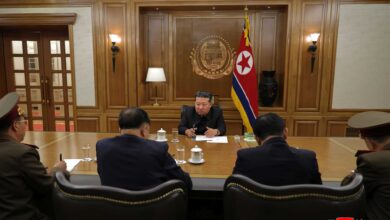On October 20, 2009 Kim Jong Il looked round the new flats on Mansudae Street.
He made the rounds of a park and apartment blocks there and went into a flat.
At the kitchen he patted tiles on the wall and praised that it was well furnished and the joints between the tiles looked nice as they were thin, adding that he had presumed they would be thick.
An official, pointing at the duct, said that the kitchen had the channel for conveying the slops for the convenience of wives.
The General said with satisfaction, “It is good that you have a duct for conveying the slops fitted into the kitchen. If the kitchen has such a channel, wives will be pleased about it.”
He opened the cupboard and looked carefully at its interior and exterior.
Staring at one of its corners, he said: It is good that the kitchen is furnished with a cupboard, but it is regrettable that it has no holes in it.
The officials wondered why there should be holes in the cupboard.
The General resumed, “If the cupboard is made airtight, the food in it may decay. It should have a hole so that it can be ventilated.”
The officials were moved by his parental care.
Now the General was passing entrance 1, block 3, section 3.
He halted in front of the entrance and asked an official, “Why is this entrance 1?”
“Section 3 has ten entrances. You have just dropped in at entrance 10,” answered an official.
“At entrance 1, block 3, section 3, I can see only the number of the entrance, and I think the number of the block should be there as well.”
He said that if there was only the number of the entrance, people from provinces would have difficulty finding their relatives’ flats, adding that they might take a wrong turn and get lost like the hero of the film of the former Soviet Union Irony of Fate or a Nice Bath.
At this joke the officials burst out laughing.
The official, who had explained the layout of the residential section to the General, felt ashamed, still smiling.
After looking round the street, he commented: The interior of the flats–kitchens, lavatories and living rooms–has been designed in such a way as to provide every convenience for the comfort of the residents in their family life. The more I see them, the more wonderful they look. The designs and building work for the flats on Mansudae Street are excellent. I have not seen such fine flats until now. They are so well furnished that I want to live in one of them.
He continued:
“The flats on Mansudae Street serve as models and standards of the flats where all our people would live in a thriving country.”
He reiterated that they were immaculate, stressing that of the units he had inspected, he gave full marks to those that were satisfactory and he would give the best marks to the flats on Mansudae Street.
He asked if the new flats would be allocated to all the households who had lived on the street before its demolition.
An official said yes and went on:
“The people often come here to see the flats. They are very happy to learn that tap-water is supplied all day long and each flat has a duct and water heater. They say they are grateful to you, asking when they can move into these new flats.”
The General underlined that prompt measures should be taken for those people and others to move into the flats and, after that, it was necessary to get feedback from them.
He said, “If all the residents who would move into the flats on Mansudae Street say that they are content with them, then I will give it ten out of ten.”
Before leaving the street, he pointed out that the ongoing project for building 100 000 flats in Pyongyang should be completed at a higher standard than the Mansudae Street project.

